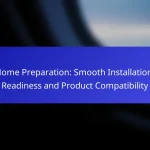What are the easiest home improvement products to install?
The easiest home improvement products to install typically require minimal tools and skills. These items often come with clear instructions and can be completed in a short amount of time, making them ideal for DIY enthusiasts.
Smart home devices
Smart home devices, such as smart plugs and thermostats, are designed for easy installation. Many of these products connect to existing Wi-Fi networks and can be set up using a smartphone app, often taking less than 30 minutes to install.
When installing smart devices, ensure compatibility with your home system and follow the manufacturer’s instructions closely. Common pitfalls include overlooking firmware updates or misplacing the device during setup.
Prefabricated cabinets
Prefabricated cabinets are a popular choice for quick kitchen or bathroom renovations. These cabinets come pre-assembled or in easy-to-assemble kits, allowing for installation without extensive carpentry skills.
To install prefabricated cabinets, start by measuring your space accurately and ensuring the wall is level. Use a stud finder to secure cabinets to the wall properly, preventing future sagging or damage.
Peel-and-stick wallpaper
Peel-and-stick wallpaper offers a simple way to refresh a room without the mess of traditional wallpaper. This product can be applied directly to clean, smooth walls and removed without damaging the surface.
For best results, measure your wall space and cut the wallpaper to size before application. Start from a corner and smooth out air bubbles as you go. Avoid applying it in high-humidity areas, as moisture can affect adhesion.
Vinyl flooring
Vinyl flooring is known for its ease of installation, often featuring a click-lock design or adhesive backing. This makes it suitable for homeowners looking to upgrade their floors without hiring a professional.
Before installation, ensure the subfloor is clean and dry. Lay out the planks in the desired pattern and trim edges as necessary. Avoid installing vinyl in areas prone to standing water unless specified by the manufacturer.
LED lighting fixtures
LED lighting fixtures are straightforward to install, with many options designed for direct replacement of existing bulbs or fixtures. They typically come with clear instructions and require basic tools like a screwdriver.
When replacing fixtures, always turn off the power at the circuit breaker to avoid electrical hazards. Consider the brightness and color temperature of the LEDs to match your space’s ambiance.
How do I choose home improvement products based on installation ease?
To choose home improvement products based on installation ease, prioritize items that come with clear instructions and user-friendly features. Look for products specifically designed for quick and simple setup to save time and reduce frustration.
Read product reviews
Product reviews are invaluable for assessing installation ease. Look for comments that specifically mention the setup process, noting whether users found it straightforward or challenging. Pay attention to reviews that highlight any missing instructions or confusing steps.
Consider focusing on reviews from verified purchasers to ensure authenticity. A product with a high number of positive reviews regarding installation is often a safer bet.
Check installation videos
Installation videos provide a visual guide that can clarify the setup process. Many manufacturers upload tutorials on platforms like YouTube, showcasing the installation steps in real-time. Watching these videos can help you gauge the complexity and tools needed for the job.
Look for videos that include tips and tricks from users who have completed the installation. This can provide insights into common pitfalls and best practices that written instructions may not cover.
Consider DIY kits
DIY kits are designed for ease of installation, often including all necessary components and tools. These kits typically come with straightforward instructions, making them ideal for those with limited experience. Check if the kit is labeled as beginner-friendly.
When selecting a DIY kit, ensure it fits your project requirements and space. Some kits may offer additional features or customization options, which can enhance usability but may also complicate installation. Always weigh the benefits against the potential for increased complexity.
What tools are needed for easy home improvement installations?
To facilitate easy home improvement installations, a few essential tools are necessary. Having the right tools on hand can significantly reduce installation time and improve the quality of the work.
Power drill
A power drill is a versatile tool that simplifies the process of drilling holes and driving screws. It can be used for various tasks, from hanging shelves to assembling furniture, making it a must-have for any home improvement project.
When selecting a power drill, consider the type of projects you’ll be tackling. Cordless drills offer mobility, while corded drills provide consistent power for heavier tasks. Look for models with adjustable speed settings for greater control.
Measuring tape
A measuring tape is crucial for ensuring accurate measurements before cutting or installing materials. It helps prevent costly mistakes and ensures that everything fits as intended.
Choose a measuring tape that is at least 25 feet long for most home projects. Look for features like a locking mechanism and a magnetic tip for ease of use. Always double-check measurements to avoid errors.
Level
A level is essential for ensuring that installations are straight and even. Whether you’re hanging pictures or installing cabinets, a level helps achieve professional-looking results.
Consider using a digital level for added accuracy, especially for larger projects. A standard bubble level is also effective and often more portable. Remember to check the level frequently during installation to maintain alignment.
Utility knife
A utility knife is a handy tool for cutting various materials, including drywall, carpet, and packaging. Its versatility makes it a staple in any toolkit for home improvement tasks.
Opt for a retractable utility knife for safety and ease of use. Keep extra blades on hand for quick replacements. Always cut away from your body and use a cutting mat to protect surfaces.
What are the benefits of easy-to-install home improvement products?
Easy-to-install home improvement products offer significant advantages, including saving time and reducing costs. These products simplify the installation process, making them accessible for DIY enthusiasts and homeowners looking to enhance their spaces without professional help.
Time-saving
One of the primary benefits of easy-to-install home improvement products is the time savings they provide. Many of these products are designed for quick setup, often requiring minimal tools and expertise. For instance, peel-and-stick tiles can be laid down in just a few hours, compared to traditional tiling methods that may take days.
By choosing products that streamline installation, homeowners can complete projects faster, allowing them to enjoy their upgraded spaces sooner. This is particularly beneficial for busy individuals or families who may not have the luxury of extended renovation timelines.
Cost-effective
Easy-to-install home improvement products can lead to significant cost savings. By reducing the need for professional installation, homeowners can save on labor costs, which can often account for a substantial portion of renovation expenses. For example, hiring a contractor for a simple project may cost hundreds to thousands of dollars, whereas a DIY approach can keep costs to just the price of materials.
Additionally, many of these products are competitively priced, making them an attractive option for budget-conscious homeowners. Investing in easy-to-install solutions can help stretch renovation budgets further, allowing for more projects to be completed within the same financial constraints.
Increased home value
Installing easy-to-use home improvement products can enhance the overall value of a property. Upgrades such as new flooring, modern fixtures, or energy-efficient windows not only improve aesthetics but also appeal to potential buyers. Homes with updated features often sell faster and at higher prices in the competitive real estate market.
Furthermore, many easy-to-install products are designed to meet current trends and standards, making them attractive to buyers looking for move-in ready homes. By focusing on improvements that add value, homeowners can make strategic investments that pay off in the long run.
How do I ensure compatibility with existing home features?
To ensure compatibility with existing home features, start by assessing the specifications of the products you intend to use. This includes checking dimensions, materials, and installation requirements to avoid any mismatches.
Check specifications
Review the product specifications carefully to confirm they align with your home’s features. Look for details such as size, weight, and material compatibility. For example, if you’re installing new windows, ensure the frame dimensions match your current openings.
Additionally, consider any local building codes that may affect installation. These regulations can dictate specific requirements for materials and methods, so familiarize yourself with them before proceeding.
Consult with professionals
Engaging with professionals can provide valuable insights into compatibility issues. Contractors or home improvement specialists can assess your space and recommend products that will work seamlessly with your existing features.
Don’t hesitate to ask for their opinions on installation methods and potential challenges. Their experience can help you avoid costly mistakes and ensure a smoother installation process.






